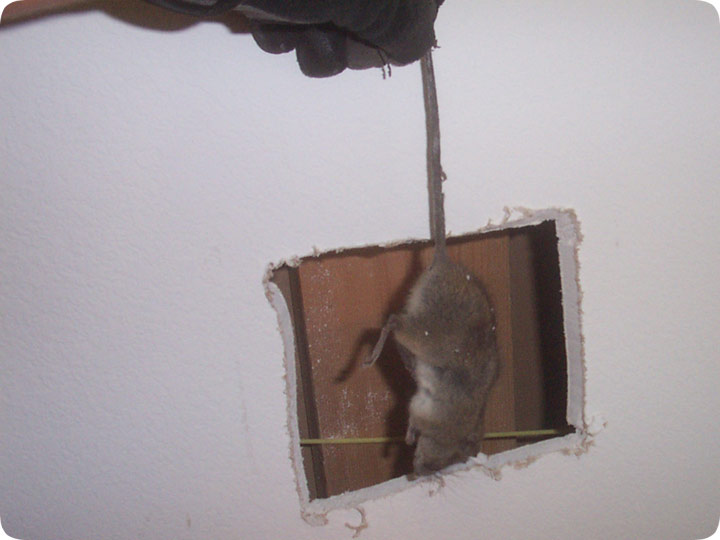-
info@aaanimalcontrol.com
Call us for help in your town
Humane Wildlife Education
Dead Rodent in a Wall

12.09.2005 - I got a call about a smell in a wall in a hall at the mall. A rat did crawl, and then it did fall, and it curled in a ball, and it did not stall, if I recall, to offend all. With its smell, which smelled bad. I sniffed it out,
then cut it out, then took it out, then looked about, and the people at the mall wondered what mistakes I had made in my life to be the guy who cuts dead rats out of the wall in the hall of the mall. But darn it all, I like my work, and if you don't
like it, you're a jerk.
I'm writing this way because I'm tired and my brain is nearly expired. When I can't write things of substance, I usually start making dumb rhymes. Okay, I'm forcing myself awake. In this particular case of dead animal
removal, I once again had to work very hard sniffing the building. It's difficult to pinpoint the source of the odor. The whole place stinks. I basically have to sniff everything like a dog, until I find it. Then I cut a hole in the wall,
remove and decontaminate, and then I fix the hole. That's about it, really. It's easy to describe, but difficult to do.
Do it yourself: Visit my How To Find and Get Rid of Dead Animals page for tips and advice.
Get professional help: Visit my Nationwide Pro Directory of wildlife removal experts.
How to remove dead rat odor -The best method to remove dead rat odor is to make sure the animal has been removed from the building. You cannot get rid of the smell until the body is gone. “Gone” can mean removed by you or decomposed by Mother Nature. If you wait for nature to take its course, the smell can linger for weeks or months. It is most practical to find the body and remove it yourself. This may not be an easy task, but it will save you a lot of nausea down the road. If you don't think you can locate the animal easily and with minimal damage to your home, there are professionals who will shoulder the responsibility for you. Many wildlife removers are also schooled in the duties of finding and removing animal remains. These experts will know how to interpret the smells and air currents within the home. Knowing where the smell originates from is a big part of removing the animal without undue damage to the interior of the building.
For more wildlife stories, click my Wildlife Blog
or click my below banner to hire a local trapper.
A rodent infestation can be extremely destructive to one's property and health. The damage of the premises can vary with the different species of these rodents. Rodents, no matter what size, are capable of rendering one's environment crippled. These rodents can prove to be even more of a bigger problem when they make their way inside of homes. Pests look for a place that provides them with safety from their predators as well as a source of food. In this case, these rodents find themselves inside the property where they are responsible for inflicting heavy damage.
Rodents not only damage the property but also one's health. They carry along with them parasites which can prove to be fatal and can cause serious complications for one's health. This problem of an infestation can multiply itself when the rodent dies. Most rodents, because of their size, have the advantage to crawl into walls or attics. This makes it impossible for people to detect their uninvited guests. In an unfortunate case such as a rodent dying while inside a wall, the job of removing the dead animal becomes harder. One does not know about the dead rat until its body starts to decompose which takes days in accordance with the size of the rodent. The decomposing of the body gives out a foul stench which is hard not to notice. The horrible smell that a rodent emits can stink up the whole property and make everyone nauseous. This smell also attracts lots of other pests.
Rodents that die in the wall are hard to find as one has to rely on their sense of smell to find the location of the rat. Since the rodent has to be removed from inside by cutting down the wall, one should be sure about the location in order to decrease the damage. A thermal camera can be used as the decomposing body gives out heat. After locating the source of the smell one should break down the wall around and remove the carcass carefully while avoiding any and all contact physically. The carcass should be placed in a bag tightly and disposed of so that it does not further contaminate the environment. After the carcass has been removed the area should be cleaned and disinfected. The wall that had been previously cut in order to remove the dead animal must be repaired. Furthermore, one should also look for cavities surrounding the house from which the rodent gained entry inside the premises in the first place. All these entry points must be sealed without any delay.




















